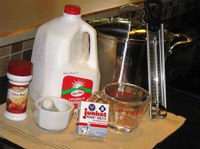Prairie Fare: ‘Say Cheese’ for a Food Science Experience at Home
(Click an image below to view a high-resolution image that can be downloaded)
By Julie Garden-Robinson, Food and Nutrition Specialist
NDSU Extension Service
“Mom, I want to learn to make cheese,” my 17-year-old daughter said.
“Cheese?” I responded, wanting to be sure I heard her correctly.
“I love cheese. I think it would be a good 4-H project,” she replied.
She certainly knows how to get my attention and mentoring. I hadn’t made cheese since I taught basic food science classes when I was a graduate student.
We found directions and she began the process. I served as the coach on the sidelines, but I also led the ingredient-purchasing mission.
She needed a gallon of pasteurized milk, citric acid (available from the canning section of the grocery store), salt, a large stainless steel pot, a thermometer and the most important ingredient, rennet.
I had to do some research to figure out where to purchase rennet locally. I found it on a website, but we needed it right away. I checked the puddings and gelatins section in a few stores and asked a couple of grocery store clerks, who responded with confused looks.
I finally traced rennet to possibly the one place in our city where it was available. It was surprisingly inexpensive.
Rennet is an enzyme that was discovered by accident when ancient people used the stomach of a cow, sheep or goat to store milk on voyages. The stomach served as a very primitive “canteen.” When the early people decided to have a milk break, they discovered the milk had become curds. Something in the stomach was creating clumps of cheese, which turned out to be an interesting food.
Until the 1990s, rennet was produced from the abomasum, which is one of the four chambers of an animal’s stomach. “Vegetarian rennet” is harvested from plants, and microbial rennet is produced by fungi or bacteria. Most rennet used today is produced through genetic engineering techniques.
The job of an enzyme, such as rennet, is to speed chemical reactions, and very little is needed. By the way, we naturally have numerous enzymes operating in our bodies that allow us to digest food, for example.
After my daughter gathered her ingredients and equipment, she adjusted the acidity of the milk with citric acid. I haven’t seen her this excited about food preparation in a long time. She crushed one-fourth of the small rennet tablet with our mortar and pestle. Obviously we will be making more cheese in the future with the remaining tablets.
The enzyme works best at a specific temperature and acidity level. My daughter heated the milk to about 90 degrees Fahrenheit, added the rennet and allowed it to stand for about 10 minutes.
“This might not work the first time, but we can try it again if it doesn’t,” I cautioned. I didn’t think it was possible the tiny amount of enzyme would create curds in a gallon of milk.
After the allotted time, my daughter cut from the top of the milk to the bottom of the pot with a long knife to make squares. She began scooping large curds into a waiting microwavable bowl.
“Mom, see, it worked!” she exclaimed as she scooped clumps of coagulated milk from the liquid whey.
She had so many clumps to scoop that we went to plan B and got a mesh strainer. Next, she microwaved the cheese a couple of times as directed, kneaded it to remove more whey and added some salt. It began to melt a bit and became a glossy, nice-sized ball of mozzarella cheese that she dropped in a bowl of ice water to cool. We put the remaining liquid in a gallon milk jug and put it in the refrigerator.
My daughter shared a little cheese with our family, but I kept hearing the refrigerator door open. She was slicing more cheese wedges for herself.
“This is so good!” she remarked.
The leftover protein-rich liquid, or whey, can be used as an ingredient in soups, smoothies, and bread or muffin recipes. We had some “whey pancakes” and “whey muffins” with the leftover whey.
In general, about 10 pounds (5 quarts) of milk are needed to make 1 pound of cheese. Hundreds of types of cheeses are available. The types of cheese vary in color and flavor, and the texture ranges from soft, fresh cheese to firm, aged cheese. Cheese provides protein and calcium, and many people with lactose intolerance can tolerate cheese.
If you are looking for ways to increase consumption of other healthful foods, consider sprinkling a little cheese on top. A recent study of school lunch showed that sprinkling cheese on vegetables and whole grains promoted the consumption of these foods. Vegetables and whole grains often are foods lacking in our diet.
Here’s a recipe filled with summer-fresh vegetables with some mozzarella cheese on top. The recipe is courtesy of The Dairy Good Cookbook, copyright 2015, Andrews McMeel Publishing. We analyzed the recipe’s nutrition profile at the NDSU Extension Service.
Summer Vegetable Frittata
8 large eggs
1/2 c. milk
1 tsp. salt
1 tsp. freshly ground black pepper
1 tsp. fresh thyme
1 tsp. finely chopped fresh sage
1 c. crumbled feta cheese
1 Tbsp. vegetable oil
1 (12-ounce) bunch thin asparagus, trimmed and cut on a diagonal into 1-inch pieces (about 2 1/2 cups)
1/2 small zucchini or summer squash, trimmed, halved and sliced into half-moon shapes
2 Roma tomatoes, chopped
1 c. shredded mozzarella cheese
Fresh thyme leaves (optional)
Preheat the oven to 400 F. Whisk the eggs, milk, salt, pepper and herbs in a large bowl. Stir in the feta cheese; set aside. Heat the oil over medium-high heat in a 12-inch oven-safe skillet. When the oil is hot, add the asparagus and cook, stirring occasionally, for five minutes or until lightly browned. Add the zucchini and tomatoes and cook for two minutes more. Pour the egg mixture over the vegetables, pulling the eggs away from the sides of the pan with a spatula so they flow to the bottom of the pan. Cook for four to five minutes. When the eggs begin to set, sprinkle the shredded mozzarella over the top. Transfer the skillet to the oven. Bake for eight to 10 minutes or until the top is golden. Cut into six wedges. Sprinkle with fresh thyme leaves, if desired. Serve immediately.
Makes six servings. Each serving has 260 calories, 17 grams (g) fat, 19 g protein, 7 g carbohydrate, 2 g fiber and 780 milligrams sodium.
(Julie Garden-Robinson, Ph.D., R.D., L.R.D., is a North Dakota State University Extension Service food and nutrition specialist and professor in the Department of Health, Nutrition and Exercise Sciences.)
NDSU Agriculture Communication - July 9, 2015
| Source: | Julie Garden-Robinson, (701) 231-7187, julie.garden-robinson@ndsu.edu |
|---|---|
| Editor: | Ellen Crawford, (701) 231-5391, ellen.crawford@ndsu.edu |



